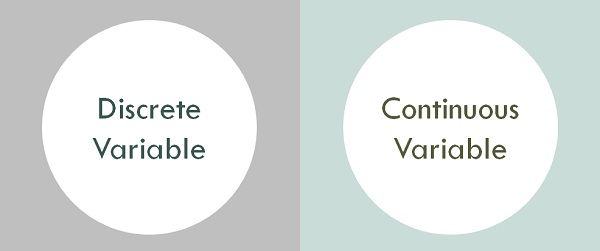Distinguish Between Discrete and Continuous Random Variables
 Variable refers to the quantity that changes its value, which can be measured. It is of two types, i.e. discrete or continuous variable. The former refers to the one that has a certain number of values, while the latter implies the one that can take any value between a given range.
Variable refers to the quantity that changes its value, which can be measured. It is of two types, i.e. discrete or continuous variable. The former refers to the one that has a certain number of values, while the latter implies the one that can take any value between a given range.
Data can be understood as the quantitative information about a specific characteristic. The characteristic can be qualitative or quantitative, but for the purpose of statistical analysis, the qualitative characteristic is transformed into quantitative one, by providing numerical data of that characteristic. So, the quantitative characteristic is known as a variable. Here in this article, we are going to talk about the discrete and continuous variable.
Content: Discrete Variable Vs Continuous Variable
- Comparison Chart
- Definition
- Key Differences
- Examples
- Conclusion
Comparison Chart
| Basis for Comparison | Discrete Variable | Continuous Variable |
|---|---|---|
| Meaning | Discrete variable refers to the variable that assumes a finite number of isolated values. | Continuous variable alludes to the a variable which assumes infinite number of different values. |
| Range of specified number | Complete | Incomplete |
| Values | Values are obtained by counting. | Values are obtained by measuring. |
| Classification | Non-overlapping | Overlapping |
| Assumes | Distinct or separate values. | Any value between the two values. |
| Represented by | Isolated points | Connected points |
Definition of Discrete Variable
A discrete variable is a type of statistical variable that can assume only fixed number of distinct values and lacks an inherent order.
Also known as a categorical variable, because it has separate, invisible categories. However no values can exist in-between two categories, i.e. it does not attain all the values within the limits of the variable. So, the number of permitted values that it can suppose is either finite or countably infinite. Hence if you are able to count the set of items, then the variable is said to be discrete.
Definition of Continuous Variable
Continuous variable, as the name suggest is a random variable that assumes all the possible values in a continuum. Simply put, it can take any value within the given range. So, if a variable can take an infinite and uncountable set of values, then the variable is referred as a continuous variable.
A continuous variable is one that is defined over an interval of values, meaning that it can suppose any values in between the minimum and maximum value. It can be understood as the function for the interval and for each function, the range for the variable may vary.
Key Differences Between Discrete and Continuous Variable
The difference between discrete and continuous variable can be drawn clearly on the following grounds:
- The statistical variable that assumes a finite set of data and a countable number of values, then it is called as a discrete variable. As against this, the quantitative variable which takes on an infinite set of data and a uncountable number of values is known as a continuous variable.
- For non-overlapping or otherwise known as mutually inclusive classification, wherein the both the class limit are included, is applicable for the discrete variable. On the contrary, for overlapping or say mutually exclusive classification, wherein the upper class-limit is excluded, is applicable for a continuous variable.
- In discrete variable, the range of specified number is complete, which is not in the case of a continuous variable.
- Discrete variables are the variables, wherein the values can be obtained by counting. On the other hand, Continuous variables are the random variables that measure something.
- Discrete variable assumes independent values whereas continuous variable assumes any value in a given range or continuum.
- A discrete variable can be graphically represented by isolated points. Unlike, a continuous variable which can be indicated on the graph with the help of connected points.
Examples
Discrete Variable
- Number of printing mistakes in a book.
- Number of road accidents in New Delhi.
- Number of siblings of an individual.
Continuous Variable
- Height of a person
- Age of a person
- Profit earned by the company.
Conclusion
By and large, both discrete and continuous variable can be qualitative and quantitative. However, these two statistical terms are diametrically opposite to one another in the sense that the discrete variable is the variable with the well-defined number of permitted values whereas a continuous variable is a variable that can contain all the possible values between two numbers.
Source: https://keydifferences.com/difference-between-discrete-and-continuous-variable.html
Post a Comment for "Distinguish Between Discrete and Continuous Random Variables"